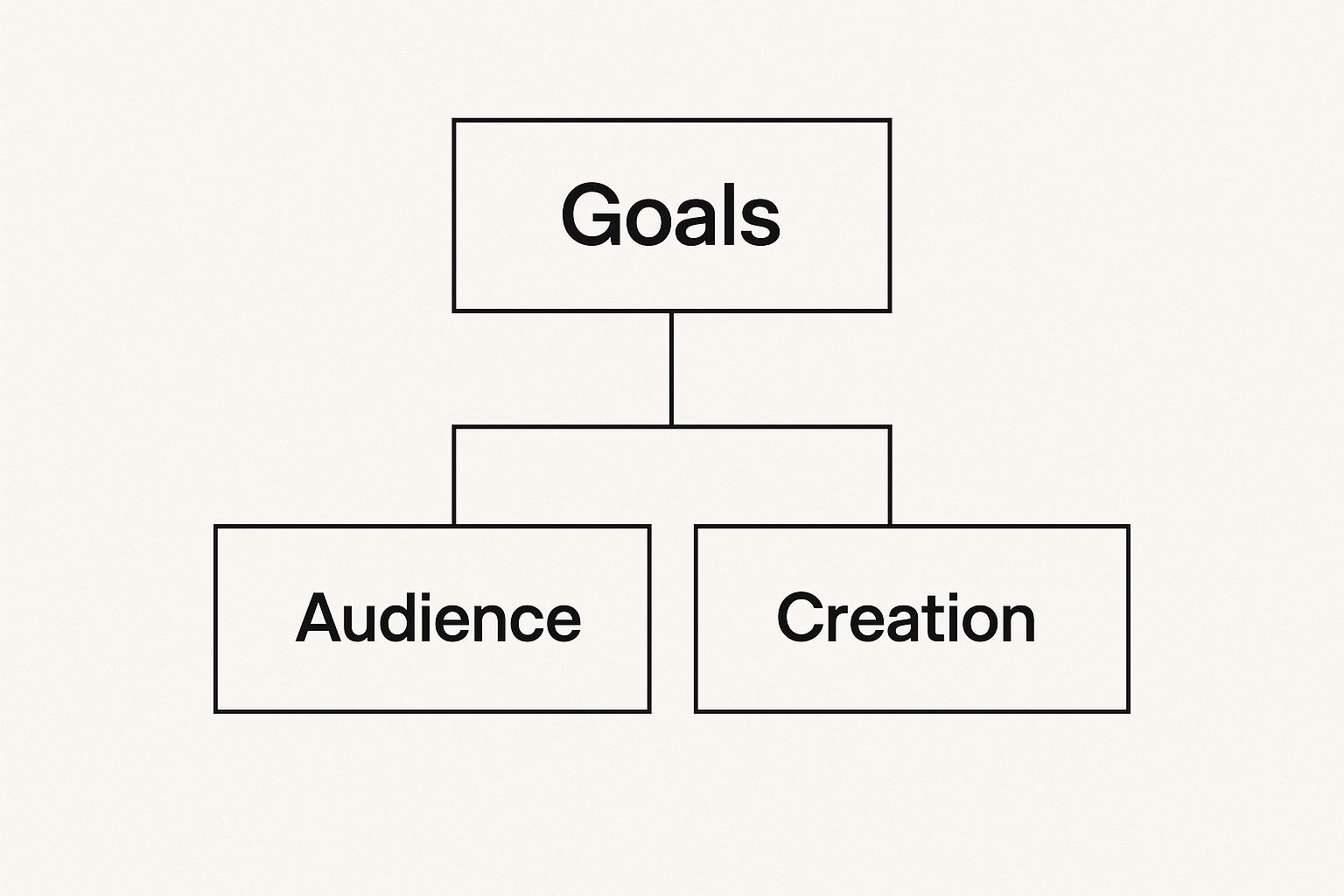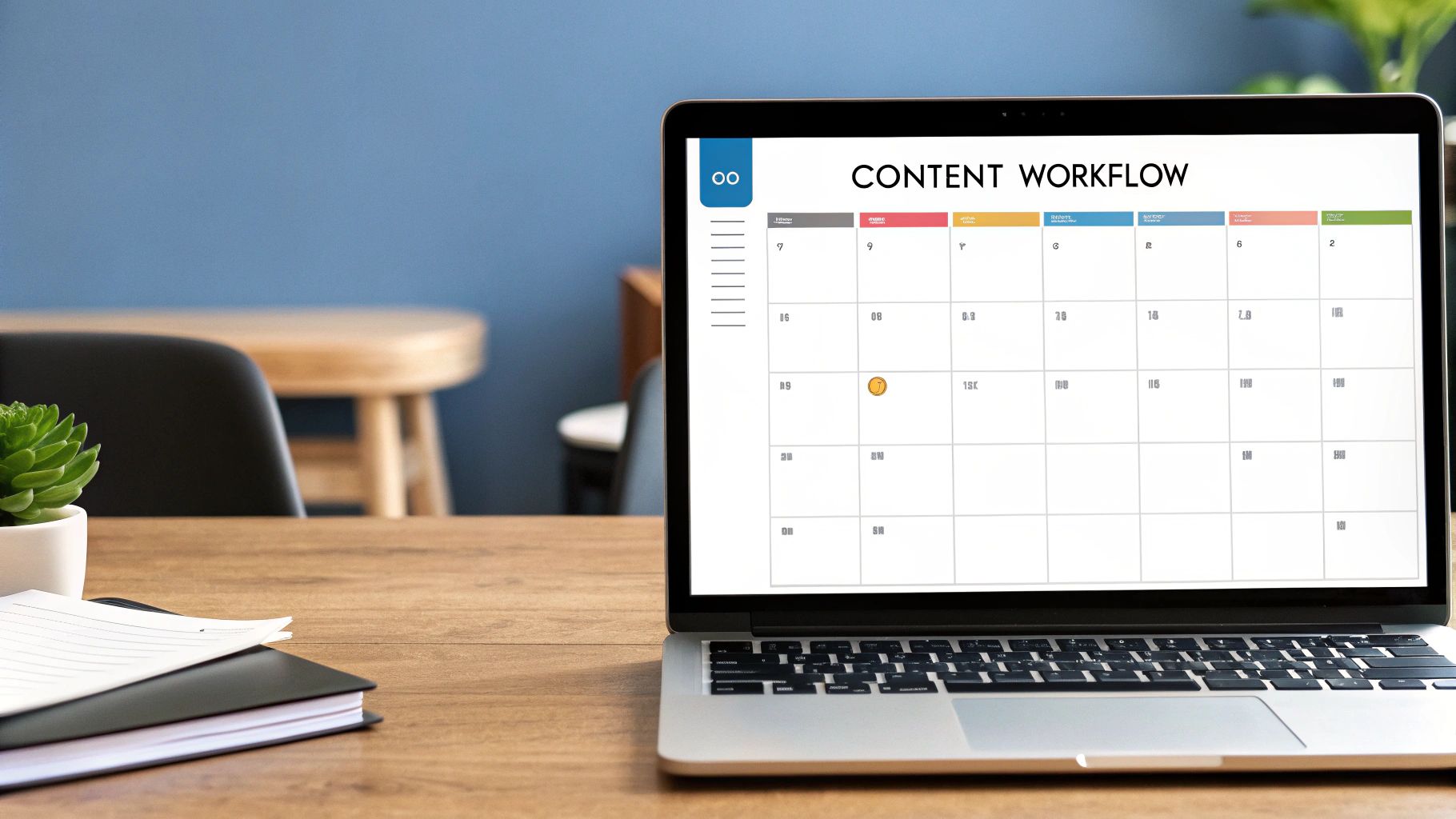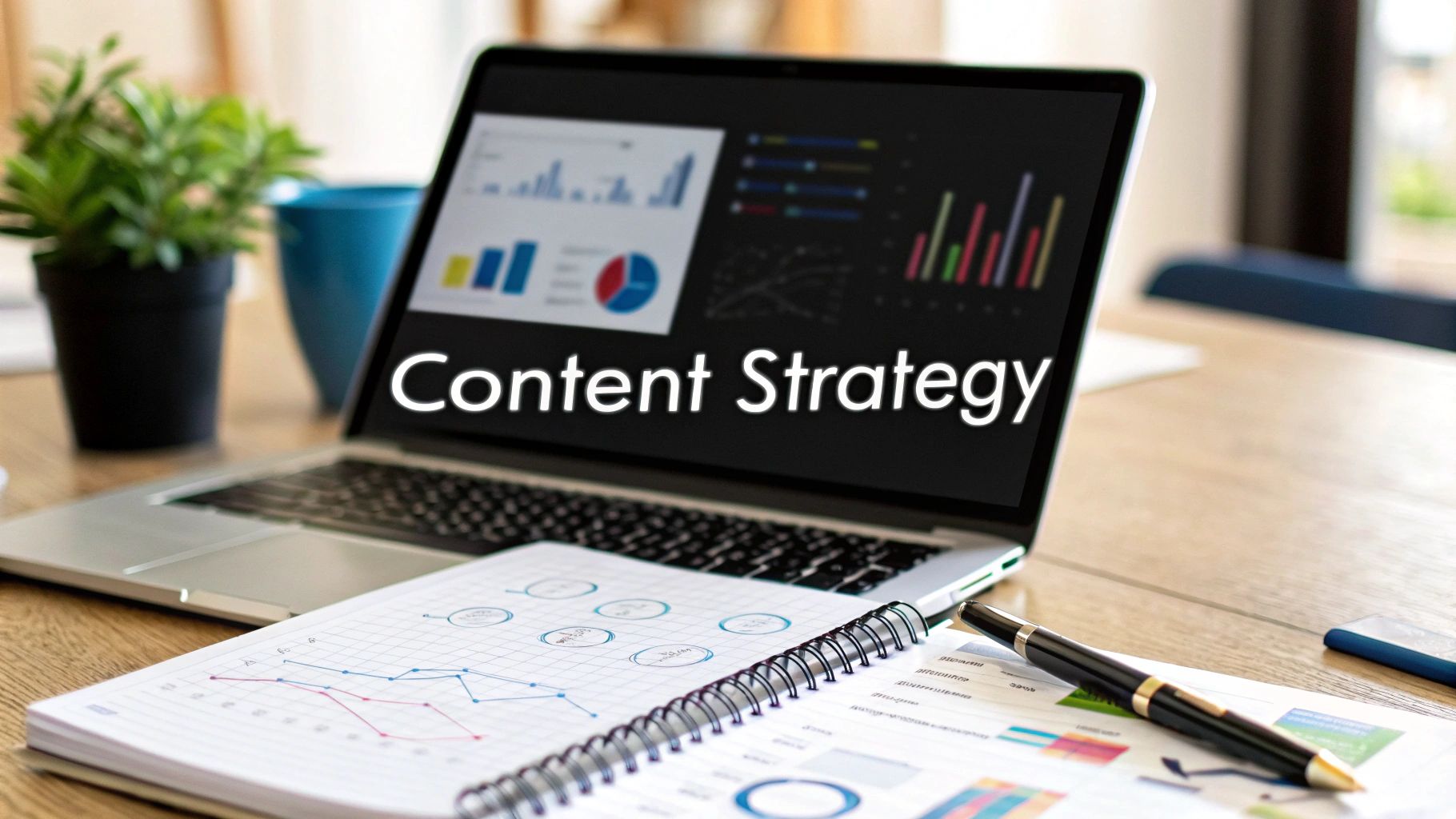A B2B content strategy is the architectural blueprint that separates winning brands from the ones just making noise. Forget random acts of content. This is your documented plan to produce, publish, and govern material that solves real customer problems, transforming your company from just another vendor into an indispensable advisor.
What a B2B Content Strategy Actually Is
Imagine you need to build a bridge to your ideal customer. You wouldn't just start pouring concrete and hope for the best, right? You'd need a detailed plan mapping out the materials, the structure, and the exact destination.
That's your B2B content strategy. It's the deliberate, documented plan ensuring every article, whitepaper, and webinar you create serves a clear business purpose. It’s the difference between shouting into the void and having a meaningful conversation with the exact people who can buy your product.
This approach is non-negotiable because the B2B buying journey is long and tangled, often involving a whole committee of decision-makers. A solid strategy guides you in creating content that speaks to everyone involved—from the end-user struggling with a technical glitch to the CFO scrutinizing the ROI. Without it, you’re just throwing disjointed tactics at the wall, hoping something sticks.
This visual breaks down the foundational pillars. Notice how it all starts with clear goals, which then inform who your audience is and what you need to create for them.

It’s a logical flow, not a lucky guess. Each element builds directly on the one before it, creating a powerful, cohesive engine for growth.
The Five Pillars of a Modern B2B Content Strategy
Every truly effective strategy is built on five core pillars. These are the structural supports that turn abstract ideas into measurable results, making sure your efforts are organized, purposeful, and locked into your company’s bigger goals.
And the data backs this up. Recent research shows that 91% of B2B businesses use content marketing, with a massive 74% reporting it successfully generates demand and leads. On top of that, 62% use it to nurture audiences, proving its value across the entire customer journey. You can explore the complete B2B content marketing trends research to see the full picture.
A winning B2B content strategy isn't about creating more content; it's about creating the right content for the right person at the right time, consistently and at scale.
To bring this to life, let’s quickly outline what each pillar represents before we dive deep. The table below frames up the essential components, each answering a critical question for your business.
The 5 Pillars of a Modern B2B Content Strategy
Think of these pillars as the foundational chapters of your playbook. Get them right, and you'll have a clear path to building a content engine that drives real, sustainable growth.
Defining Your Audience and Business Goals

A solid B2B content strategy starts with two questions, and they're not small ones: Who are we talking to? and What are we trying to achieve?
Nailing the answers is what separates content that drives real revenue from content that just… exists. Without that clarity, you're not building a strategy; you're just throwing stuff at a wall and hoping something sticks.
Think of it like an architect. They wouldn’t lay a single brick without knowing who will live in the building and what it’s for. Your content is no different. It needs a clear purpose and a defined audience to stand a chance.
Before you ever write a single headline, you have to get good at how to identify your B2B target audience, their biggest headaches, and what they're trying to accomplish. This isn't about demographics; it's about understanding the actual people behind the job titles.
From Generic Personas to Precise ICPs
A lot of marketers stop after creating a basic buyer persona—something like "Marketing Mary." It's a start, but a truly effective B2B strategy needs to be way more precise. You need a detailed Ideal Customer Profile (ICP).
An ICP isn't some made-up character. It’s a razor-sharp description of the perfect-fit company for your solution. It lays out the firmographics—industry, company size, annual revenue—that scream "high-value prospect." This is the bullseye you're aiming for with every piece of content.
Once you know the company, you can map out the buying committee inside it. Because in B2B, you're almost never selling to just one person. A single deal could involve:
- The End-User: The one who will actually use your product and is worried about their daily workflow.
- The IT Manager: The one focused on security, integration, and whether your tech plays nice with theirs.
- The Department Head: The one trying to hit team KPIs and improve overall productivity.
- The CFO: The one who only cares about ROI, total cost of ownership, and the budget.
Each of these people has different worries, different questions, and a different definition of success. Your content has to speak to all of them.
Connecting Content to Measurable Business Goals
With your audience locked in, you can finally set goals that actually mean something. Fluffy objectives like "increase brand awareness" are impossible to measure and do nothing to bridge the gap between marketing and sales. Instead, your content strategy needs to be built on SMART goals.
You've heard it before: Specific, Measurable, Achievable, Relevant, and Time-bound. But it's a cliché for a reason. It works. It connects your content directly to business outcomes.
A SMART goal transforms your content from a creative exercise into a strategic business driver. It gives every article, webinar, and case study a clear job to do.
Let's look at how this plays out. It’s the difference between a vague wish and a powerful, actionable target that guides everything you create.
Vague Goal vs. SMART Goal
This level of focus is what makes a B2B content strategy work. It forces you to ask the hard question about every piece of content: "How does this help us hit our specific, measurable goal?"
When you can answer that, you’re no longer just creating content. You’re building a predictable engine for growth.
Choosing Your B2B Content Formats

Once you know who you’re talking to and what you’re trying to achieve, the next question is how. In B2B, picking content formats isn’t just about what’s trendy—it’s about picking the right tool for the right job.
Think of it like this: you wouldn't use a tweet to explain a complex API integration, and you wouldn't write a 50-page ebook to announce a minor feature update. A one-size-fits-all approach just wastes time and money.
The goal is to build a content ecosystem where each piece has a purpose. Each format should be chosen to meet your buyer exactly where they are, turning your content from a monologue into a genuinely helpful conversation.
Aligning Formats with the Buyer's Journey
The B2B buying process is messy, but it generally moves from awareness to consideration and finally to a decision. Mapping your content formats to these stages makes sure you’re giving the right information at the right time.
This stops you from scaring off a new prospect with a super-dense whitepaper or, worse, underwhelming a serious buyer with a fluffy, top-level blog post. It's all about progressive value.
Awareness Stage (Top of Funnel): Your audience is just realizing they have a problem. They need educational, easy-to-digest content that doesn't feel like a sales pitch. Your job is to be helpful and build a little trust.
- SEO-Driven Blog Posts: Answer their "how to" and "what is" questions.
- Infographics: Break down data or complex ideas into something they can scan in 30 seconds.
- Short Explainer Videos: Quickly introduce a core concept or problem.
Consideration Stage (Middle of Funnel): Okay, now they’re actively looking for solutions. This is your chance to go deeper, show off your expertise, and explain how you solve their specific problem.
- Webinars: Live, interactive sessions are perfect for demonstrating your product's real-world value.
- In-depth Guides & E-books: Become the go-to resource on a key topic they’re researching.
- Case Studies: Nothing builds confidence like showing how you’ve helped companies just like theirs.
Decision Stage (Bottom of Funnel): They're narrowing down their options and are close to a decision. Your content should remove any final doubts and make it easy to say yes.
- Product Demos & Trials: Let them get their hands on your solution.
- Comparison Sheets: Make it easy for them to see how you stack up against the competition.
- Detailed Pricing Pages: Be clear and transparent. No one likes surprises here.
The Power of Long-Form and Video Content
In the B2B world, two formats consistently punch above their weight: deep-dive written content and video. They work in different but complementary ways. Long-form content establishes you as an authority, while video creates a human connection and shows value in minutes.
The data backs this up. A huge 87% of B2B marketers plan to increase their video budgets, because they know it’s one of the best ways to engage busy decision-makers. At the same time, the average word count for a first-page Google result hovers around 1,447 words, proving that comprehensive, expert articles are key for getting found.
Selecting the right content format is an act of empathy. It shows you understand not just what your audience needs to know, but how they prefer to learn it.
Building a Balanced Content Ecosystem
A truly great strategy never relies on a single format. You need a mix—an ecosystem where different content types work together to guide prospects along their journey.
This multi-format approach keeps people engaged and appeals to different learning styles. It also gives you more ammo for promotion. You can chop up a webinar into short clips for LinkedIn, turn a blog post into an infographic, or expand a case study into a detailed guide.
This integrated system makes sure your brand is present and helpful at every turn. For more ideas on keeping your content calendar full, check out our guide on effective content generation ideas. By thoughtfully picking and combining formats, you build a powerful engine that attracts, educates, and converts the right customers.
Building Your Content Creation Engine

A brilliant B2B content strategy is just a collection of good ideas until you build a reliable system to bring it to life. That system is your content creation engine—a repeatable process that turns strategic goals into high-quality assets, again and again.
Without a documented workflow, even the most talented teams eventually descend into chaos. Deadlines get missed, quality becomes inconsistent, and good ideas never see the light of day.
Think of it like an assembly line in a high-end car factory. Every step is defined, every role is clear, and quality checks are built in from start to finish. Your content production needs that same methodical approach, whether you’re a big in-house team or a handful of trusted freelancers.
This engine is what makes sure every blog post, webinar, and research report is strategically sound, on-brand, and delivered on time. It's the operational backbone of your entire strategy.
Step 1: From Ideation to Keyword Research
Every great piece of content starts with an idea, but that idea needs to be validated with data. Strategic ideation isn’t about pulling random topics out of a hat; it’s about zeroing in on customer problems your content can actually solve.
Your best source? The front lines. Talk to your sales and customer success teams. They know exactly what questions prospects and customers are asking every single day.
Once you have a list of potential topics, it's time for keyword research. This is where you confirm there’s a real audience searching for the solutions you’re providing. Focus on keywords with clear intent that map directly to your ideal customer’s pain points.
Look for those lower-volume, high-intent phrases that signal a user is deep in the buying journey, like "[your competitor] alternatives" or "[your product category] pricing models." These are gold.
Step 2: Creating Effective Content Briefs
A detailed content brief is the single most important document in the entire workflow. It’s the blueprint that guides your writer, ensuring the final asset aligns perfectly with your goals, SEO requirements, and brand voice. A weak brief guarantees endless revisions and off-target content.
A powerful brief should include:
- Target Keyword and SEO Specifics: List the primary keyword, related secondary keywords, and any internal linking opportunities.
- Audience and Stage: Who is this for? Be specific. A CFO at the decision stage needs a totally different message than a marketing manager at the awareness stage.
- Core Angle and Outline: Give your writer a unique angle for the topic and a structured outline with the key points you want covered in each section.
- Competitor Analysis: Link to the top-ranking articles for the keyword and briefly explain what they do well and where you can do better.
A great content brief doesn't just tell a writer what to write; it shows them how to win. It transfers strategic insight from the marketer to the creator, aligning everyone on a single vision of success.
This upfront investment of time saves countless hours on the back end.
Step 3: The Rigorous Editing and Approval Process
Once a draft is done, it enters a structured review cycle. This isn't just about catching typos. It’s about sharpening the message, verifying accuracy, and locking in brand consistency. A clear, multi-stage approval workflow maintains quality without creating frustrating bottlenecks.
Here’s a simple, effective workflow that just works:
- First Edit (Content Strategist): The strategist reviews the draft against the brief. They're checking for strategic alignment, logical flow, SEO optimization, and overall messaging.
- Second Edit (Subject Matter Expert): An internal expert reviews the content for technical accuracy, depth, and credibility. This step is absolutely crucial for building trust with a sophisticated B2B audience.
- Final Polish (Proofreader): A final reviewer does a detailed check for grammar, spelling, style guide compliance, and formatting.
This tiered approach ensures that different experts are focused on different aspects of quality, resulting in a polished, authoritative final piece. By systemizing your process from idea to approval, you build a dependable engine that can actually scale your content operation.
Measuring B2B Content and Proving ROI
Creating great content is only half the battle. The other, and arguably harder, half is proving it actually works. This is where so many B2B marketers get stuck, presenting vanity metrics like page views to a leadership team that only wants to hear about revenue.
A winning content strategy for B2B has to answer the big question: "What was our return on this investment?" Answering it means shifting your focus from high-level activity metrics to the business outcomes that actually move the needle.
Think of it this way: telling your CEO you got 10,000 page views is like a construction foreman reporting they used 10,000 nails. It's an activity, sure, but it says nothing about whether the bridge you're building is safe, on schedule, or actually getting people where they need to go.
Moving Beyond Vanity Metrics
The first step is drawing a hard line between metrics that feel good and metrics that drive business decisions. Vanity metrics are easy to track but give you almost zero insight into how content is affecting the bottom line. Actionable metrics, on the other hand, connect the dots between content and real sales activity.
This shift is crucial. Companies are dedicating an average of 33% of their marketing budgets to content, and 54% plan to spend even more. But despite the investment, a shocking 43% don't track ROI with any dedicated tools. That's a huge gap between spending money and knowing if it's working. You can dig into more on how to measure content performance to close that gap.
Let's break down the difference with a clear comparison.
B2B Content Metrics That Truly Matter
The table below cuts through the noise, showing you exactly where to focus your attention. It's the difference between reporting on "what we did" and "what we achieved."
Focusing on the metrics in the right-hand column changes the entire conversation. You stop talking about traffic and start talking about revenue.
Connecting Content to Revenue
The real goal is to link a specific piece of content to a closed deal. This isn't magic; it just requires tight integration between your website analytics (like Google Analytics) and your CRM (like Salesforce or HubSpot).
Here’s a practical, step-by-step path to making that connection:
- Track the First Touch: Use UTM parameters on every link you share. When a prospect first discovers your brand by downloading a whitepaper, your CRM should tag that asset as their entry point. Simple.
- Monitor Subsequent Engagement: As that prospect comes back for more—attending a webinar, reading blog posts—your system should log every interaction. This builds a complete picture of how your content is nurturing them through their buying journey.
- Attribute the Opportunity: When a salesperson creates an opportunity (a potential deal) for that contact in the CRM, you can now see every piece of content they consumed on the way there.
- Calculate Content-Sourced Revenue: When that deal is won, the revenue can be directly attributed back to the content that influenced the journey.
This process moves you from saying, "Our content is getting traffic," to saying, "Our Q2 whitepaper directly influenced $150,000 in new pipeline and sourced $45,000 in closed-won revenue." That’s a conversation that gets attention.
Building Your Performance Dashboard
You don’t need a fancy business intelligence tool to get started. A simple dashboard—even a spreadsheet—can work wonders for reporting on the metrics leadership actually cares about. For a deeper look at what to include, check out our guide on key content marketing metrics.
Your dashboard should give a clear, at-a-glance view of performance, focusing on trends over time, not just single data points.
Essential Dashboard Components:
- Marketing Qualified Leads (MQLs) Generated by Content: How many real leads did our content produce for sales this month?
- Sales Qualified Leads (SQLs) Influenced by Content: Of those leads, how many did sales accept and start actively working?
- Content-Sourced Pipeline Value: What is the total dollar value of sales opportunities that started with a content touchpoint?
- Content-Attributed Revenue: How much closed-won revenue can we trace back to content engagement?
By consistently tracking and reporting on these outcomes, you turn your B2B content strategy from a cost center into a documented revenue driver. This data-driven approach not only justifies your budget but also gives you the insights you need to make your next move even smarter.
Your Path to a Powerful B2B Content Strategy
We've covered the framework, but building a dominant B2B content strategy starts right now. The principles here—from goals and audience research to creation, distribution, and measurement—aren't a checklist you complete once and file away. Think of your strategy as a living, breathing thing that needs constant attention and fine-tuning.
Success isn't built on one brilliant campaign. It’s built on a deep, almost obsessive understanding of your audience’s real pain points. It’s forged through a relentless commitment to showing up consistently, even when the results aren't immediate. And most importantly, it's proven with the courage to measure what actually moves the needle for the business, not just what looks good on a dashboard.
The most powerful B2B content strategy is an iterative loop: listen to your audience, create valuable solutions, measure what works, and do it again. It’s how content stops being a marketing task and becomes a core business asset.
When you nail these pillars, you turn simple blog posts and emails into a strategic engine for growth.
Turning Strategy Into Sustainable Growth
This is how your content builds undeniable authority in your niche. It’s how you generate a predictable stream of high-quality leads and drive sustainable revenue. It’s the difference between being just another vendor in a crowded market and becoming the go-to expert your ideal customers can’t afford to ignore.
Here’s the simple truth:
- Audience obsession makes sure your content always hits the mark.
- Consistent execution builds momentum and trust over time.
- Meaningful measurement proves your value and helps you make smarter bets.
When you’re ready to put these pieces together, you need a structured approach. To help you get started, our complete content marketing strategy framework gives you actionable templates and a deeper dive into building your plan from the ground up.
This path takes discipline, but the payoff is huge. You'll build an asset that pays dividends long after you hit publish, securing your company’s spot as a trusted leader.
Common Questions (and Straight Answers)
Even with a perfect plan on paper, questions always come up. Here are some of the most common ones we hear from marketers trying to get their B2B content strategy off the ground, along with no-fluff answers.
How Long Until We See Results from This?
This is the big one. While you might see early glimmers of hope—like a bump in organic traffic or more social engagement—within the first three months, real business results take longer.
Expect to see a steady stream of good, qualified leads coming in after about six to twelve months of consistent work. B2B sales cycles are long, and you're building authority and trust from scratch. Think of it as a marathon, not a sprint. The single most important thing you can do is show up consistently with valuable content.
What's the "Best" Content Format for B2B?
There isn’t one. A smart content strategy for B2B is all about using the right tool for the right job. You need a mix of formats that align with where your buyer is in their journey.
- Top of Funnel: This is where foundational blog posts and articles shine. They build your SEO footprint and get your name on the map.
- Middle of Funnel: When someone is seriously considering solutions, you need something meatier. In-depth white papers and interactive webinars are perfect for capturing leads here.
- Bottom of Funnel: To seal the deal, you need proof. Detailed case studies and clear product demos are what push a prospect over the finish line.
The best format is the one that answers the specific question your buyer has right now. Your job is to have that answer ready in the format they're looking for.
We're a Small Company. How Can We Compete with a Huge Enterprise?
You don't win by outspending them. You win by being smarter, more focused, and more nimble. Forget trying to be everything to everyone. Instead, find a specific, well-defined niche and completely own it.
Your goal is to become the undisputed expert for a very particular type of customer. Go deep on their problems in a way your massive competitors can't because they have to stay broad. Create the most helpful, insightful content that solves their unique challenges with absolute clarity.
The same goes for distribution. Don't waste your energy on ten different platforms. Pick one or two channels where your audience actually lives—whether that's a niche LinkedIn group, an industry forum, or a specific subreddit—and master them. High-quality, focused content will always beat a huge, unfocused budget. It's how you build a loyal following and become the go-to authority in the space that matters.
Ready to make your SaaS brand the go-to authority in your niche? PimpMySaaS specializes in building your presence on platforms like Reddit, ensuring you're part of the conversations that matter and get cited by LLMs like ChatGPT. Learn how we can amplify your content strategy.
